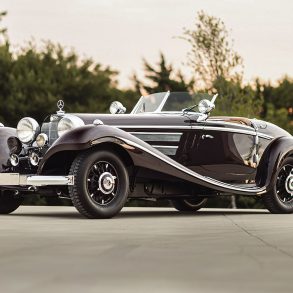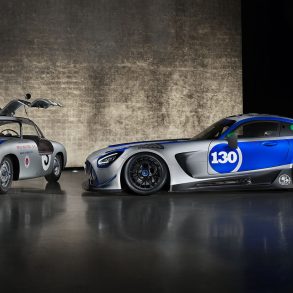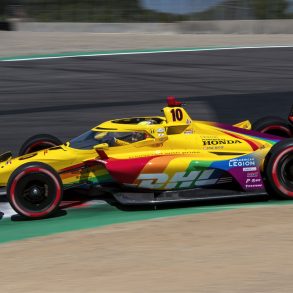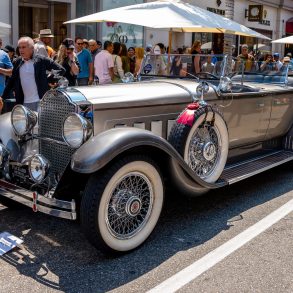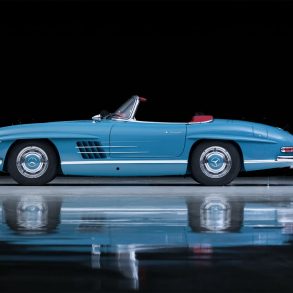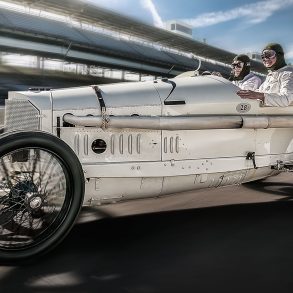Mercedes W 196
Car: Mercedes W196 / Engine: 8-Cylinder In-line / Maker: Mercedes-Benz / Bore X Stroke: 76 mm X 68.8 mm / Year: 1954 / Capacity: 2,496 cc / Class: Formula 1 / Power: 257 bhp at 8,200 rpm / Wheelbase: 2350, 2210 and 2150 (Monaco) mm / Track: 1330 mm in front, 1358 mm rear / Weight: 650 kg (monoposto), 750 kg (streamline) / Tires: Tires were 6.00 x 16 front and 7.00 x 16 rear.
In 1954 Auto Union was now known as Audi and no longer racing. Alfa Romeo also was out of the picture but Maserati and Ferrari, building and racing his own cars were very much in.
The British teams were just beginning to make some noise. Mercedes-Benz’s re-entry into Grand Prix racing coincided with the establishment of new regulations that were heavily biased against supercharged engines which were limited to only 750 cc. After being dominated by Ferrari with cars that actually were developed to Formula 2 specifications it was hoped that the new regulations would entice other manufacturers to enter the fray. Mercedes set up a racing department headed by Rudolf Uhlenhaut while the race team was once again managed by the legendary Alfred Neubauer. The were Juan-Manuel Fangio and the Germans Karl Kling and Hans Hermann. In 1955 the lineup was bolstered when the young British sensation Stirling Moss joined the team.
One of the initial design goals or the new car was to maximize it’s drivability by providing as wide a power band as possible. Towards this end the new cars were powered by a normally aspired straight eight fitted with desmodromic valves and fuel injection. Using experience gained from their aero engines and in collaboration with Bosch, Mercedes built the first successful Grand Prix car to have fuel injection. Four camshafts operated 16 valves. Fuel provided by Esso, designated RD1 contained a witches brew of 45% benzol, 25% methyl alcohol, 25% high octane petrol, 3% acetone and 2% nitro-benzine. Power was controlled through a five speed gearbox that would prove to be a distinct advantage to their rivals four speed versions.
The chassis employed small diameter tubing in a space frame design while stopping power was supplied by inboard brakes front and rear. If the running gear seemed fairly conservative for a company such as Mercedes it was the body, that most set the cars apart. Using a loophole in the rules, the cars sported an all-enclosing streamlined shell whose low bonnet line was made possible by the engine being canted on its side. Initial tests o the proposed bodywork had been conducted using a 1:5 scale wooden model using the wind tunnel at the Motor Research Institute o the Stuttgart Technical College.
The streamlined bodies caused a sensation and served the team well at fast circuits such as Reims but the debacle at the British Grand Prix led to an open wheel version which was later driven in the remainder of the races that required a more precise placement of the car relative to the circuit’s corners! Part of the improvement that resulted from the open wheel bodywork was a reduction in the streamlined versions tendency for marked understeer. The handling characteristics of the cars continued to be a problem for the life of the cars as different wheelbase lengths of 92, 87 ½ and finally 85 inches were tried with mixed but inevitably successful results.
During testing prior to their debut at Reims it was found that fuel consumption was 40 liters per 1000 km instead of the expected 35 liters. This would result in the car coasting to a halt 48 km short of the end! With no time to waste Uhlenhaut, a noted driver in his own right hot-footed it back to Stuttgart to supervise the building of supplementary fuel tanks for the race on Sunday. Though it was somehow fitting that the German make would introduce it’s latest super car at the French Grand Prix it unfortunately lacked a credible French rival. That did not stop the 300,000 fans who came to view the event which started on the right foot when Fangio was given 50 bottles o champagne or breaking the 200km/h barrier. The race turned into an inner team battle for Mercedes when their major rivals all suffered mechanical problems, Fangio claiming first blood over his teammate Kling.
The Mercedes would triumph in 9 of the 12 races they would enter over the next two years before once again leaving the sport having demonstrated the same superiority as their pre-war brethren.















